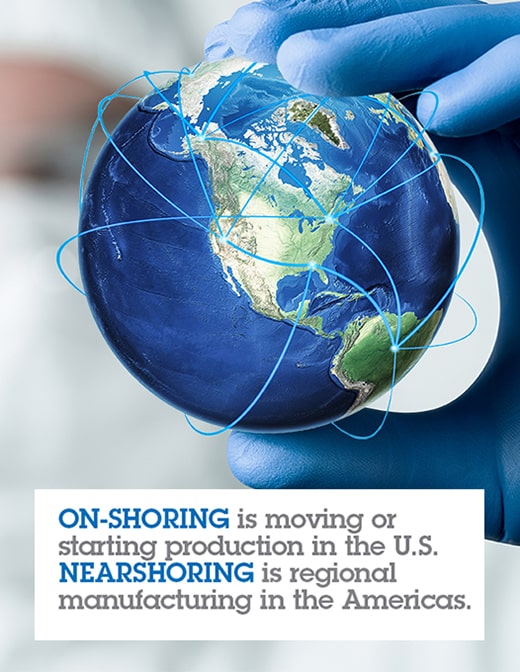
The COVID-19 pandemic has driven unprecedented worldwide demand for pandemic-related medical supplies. While effective for reducing costs in healthcare, the United States’ reliance on global sources impacted supply chain resilience. The pandemic highlighted the need for diversity in sources for pandemic medical supplies, including building domestic manufacturing capability in the U.S.
It’s important to expand domestic and nearshored manufacturing capacity for critical products to augment global sources. Leveraging the strengths of each manufacturing location (U.S., regional and global) will result in the highest level of supply chain resilience at the lowest overall cost.
These policies should apply to all products important for pandemic response, including:
- PPE
- Testing supplies
- Needles/syringes
- Infection prevention products
Domestic production is often more expensive than global sources and can’t always be supported through normal market commerce. The federal government will need to support and fund a diversified sourcing strategy in partnership with the private sector.
HIDA recommends:
1. Prioritizing companies with experience in healthcare: Manufacturing medical grade products requires specialized expertise and capability. Companies selected to receive government support to on-shore production must have an extensive track record of meeting FDA-quality standards for medical grade products.
2. Leveraging the established public/private partnerships: The private sector already is actively ramping up investments in U.S. manufacturing. Government incentives and commercial market investments should complement and reinforce each other in a comprehensive plan that includes:
- Assessment of on-shoring viability: A detailed plan is needed to target critical supply categories, assess viability of U.S. manufacturing such as raw materials, cost and regulatory issues. A baseline of global production needs to be established to enable setting and monitoring progress against clear production targets for U.S. manufacturing.
- Meaningful incentives: Any plan should include infrastructure investments, tax incentives, loan programs, and grants. These incentives provide guidance to industry to expand and establish industrial capability, foster research and development, and enhance private sector investments.
3. Supporting the existing supply chain: Payment and trade policies can be used to provide a consistent demand signal to the commercial market for long term viability. Policies should include:
- Direct procurement: The government should structure its own purchases of medical products through long term, multi-year contracts of committed purchases with manufacturers and distributors.
- Trade agreements: Leverage existing regional trade agreements to facilitate U.S. and regional production opportunities.
- Reimbursement: Assess Medicare and Medicaid payment policies across the continuum of care to identify opportunities to incentivize domestic purchasing.
- Avoid unintended consequences: Federal government purchases can be so large they move markets and disrupt the supply chain. Whenever possible, these purchases should be done in a planned, measured way with regard to quantities and timing.
Fostering diversified sourcing is a key component of HIDA’s comprehensive framework for building a more robust pandemic response infrastructure. To learn more, visit HIDA.org/UnderstandingHealthcareDistribution.